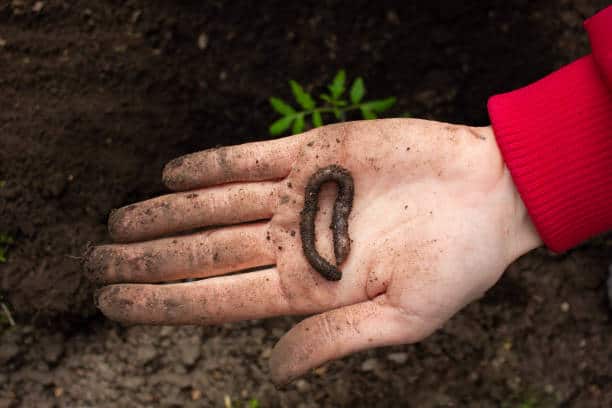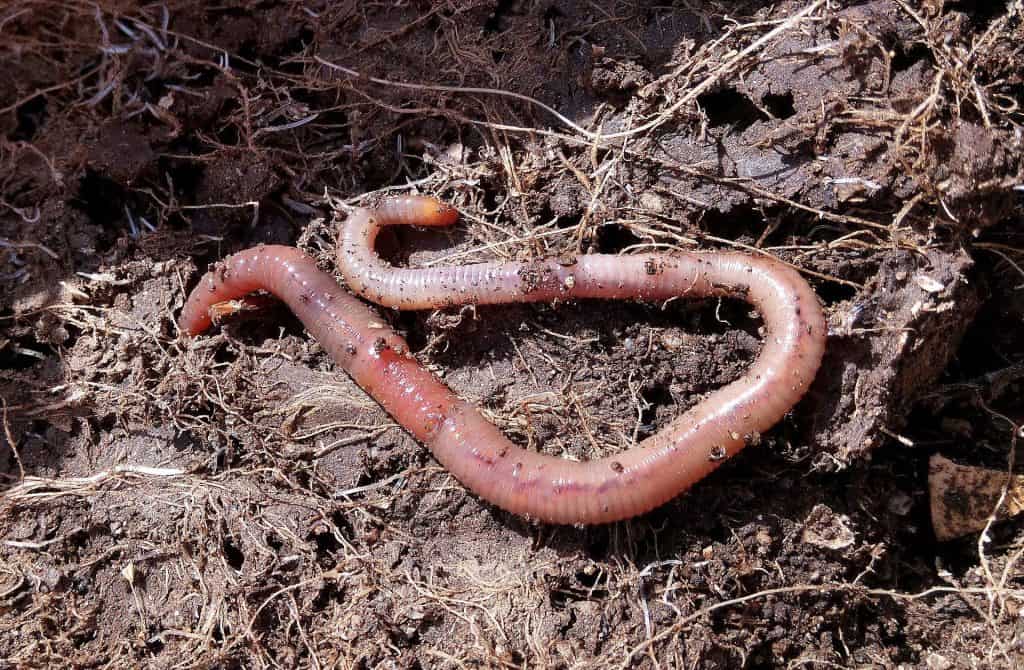Because they can aerate the soil and convert organic materials, like leaves, into essential nutrients for plants to thrive, earthworms are helpful to plants. It could seem like a smart idea to add them to potted plants to encourage your plant’s growth.
Should you give your potted plants earthworms?
The soil used to pot the plant may not have enough food for earthworms to thrive and proliferate like ground soil or in a vermicompost, thus they will eventually die or crawl away. Therefore, earthworms shouldn’t be added to potted plants. Use casting tea as a foliar application on the plant as well as on the soil of the potted plant.

The appropriate circumstances will allow earthworms to remain in a pot and continue to offer all the advantageous effects associated with their presence in the soil.
This article will examine both useful and harmful worms, the environments in which they grow, and whether or not plants and worms can coexist in a potted setting.
Table of Contents
Can Earthworms Live in Potting Soil?
In potting soil, worms cannot survive unless the proper conditions are present.The word “potting soil” refers to a variety of soils created especially for blooming and potted plants. Its texture is frequently loose to allow for plant aeration.
The following soil characteristics appeal to earthworms
- The soil must be wet (not Soggy or dry)
- pH 6.5 somewhat acidic soil (6.6 to 6.8)
- Possess a lot of organic food.
- You need chilly soil.
- The texture of the soil must be somewhat loamy (not loose)
The circumstances that are beneficial for the plant may be compromised and the plant may even die if you can get the potting soil to a favorable condition for earthworms.
Are Worms Good or Bad for Plants?
Depending on the worm species in the soil, worms can be beneficial to plants.
Let’s investigate earthworms. Due to their body moisture content of 80%, earthworms are long, slender, red to pink, and they like moist environments.
Earthworms eat everything in their path as they tunnel into the dirt. Because of the helpful microorganisms in the worm’s intestine, whatever it consumes is 10 times more beneficial to plants than what it originally was.
Some worms have been observed eating nematodes and other parasitic, non-beneficial creatures.
The growth of the plant may be adversely affected by other worms, like cutworms.
Cutworms feed on the stem by curling their bodies around it. The plant is severed just above the soil’s surface as a result of this feeding. Source.
Types of Worms in Potted Plants
Because the soil is ideal for hosting various worm colonies, potted plants can draw various worm species.
As a result, we might not even be aware that potting soil contains a variety of worms. These worms can be both good and unhealthy for the development of plants.
Among the beneficial worms in soil are:
- Earthworms, often known as red wigglers, can be added to potting soil or drawn to it and have a number of advantages (if they stay)
- Nematodes, whether bacterial or fungal, may serve as helpful indicators of soil quality due to their enormous diversity and involvement in a variety of processes at various soil layers. These nematodes consume fungus and bacteria that are detrimental to plants.
- Grub WormsThese worms can wreck havoc by chewing on the roots of your plants. They are present during the larval stage of a beetle’s life cycle.
- Plant parasitic nematodesNematodes fall into this category in a variety of forms, and they all destroy plants and crops. These nematodes have several modes of operation, including attacking plant roots and ingesting host plants. (source) These are Nematodes of the stem and bulb seeds gall nematodes Nematodes on leaves
- Pot worms are typically found in soil conditions that are not attractive to earthworms and contribute to soil aeration and the decomposition of organic matter into nutrients.
- Millipedes: These worms, which mostly consume dead plant matter like mulch or fallen leaves, do not harm plants. They in turn provide the soil with advantageous nutrients.
- Nematodes of the stem and bulb
- seeds gall nematodes
- Nematodes on leaves
How to Get Earthworms into Potted Plants Naturally?
In order for worms to naturally enter a potted plant, the plant must be partially submerged in the soil of your yard and have some sort of food that the worms may consume.
The correct circumstances for earthworm survival must be present for them to be attracted to a plant pot.
Earthworms adore eating organic stuff and are made up of 80% water. Because of this, make sure the soil is moist but not too wet for them to breathe.
- Use a soil with a loamy texture that is slightly acidic (pH 6.6 to 6.8)
- Put a lot of organic debris on the surface for the worms to eat, such as leaves and vegetable peels.
- To keep the soil warm and moist, use organic mulch.
- Avoid fertilizing the soil with inorganic chemicals.
In a potted setting, it is challenging to replicate these kinds of conditions. Worms won’t just want to burrow into a potted plant, even if the aforementioned requirements are met.
To give the worms a way in, the pot should be buried at least three inches into the bare ground and have holes at the bottom.
And even that is overly optimistic. Crossing our fingers!
How do you Get Rid of Earthworms in Potted Plants?

You must first ascertain how the worms entered the potted plants in the first place.
You might not need to worry about the worms if they were put with compost casting because they are the beneficial kind and would provide a lot of value to the potted soil if they decide to stay there.
The worms would eventually either depart on their own or perish because the potted soil would not be suitable for their survival.
You might have another sort of worm that might do more harm than good to your plant if the soil used to pot the plant was topsoil or raw garden soil.
Nematodes, cutworms, and caterpillars are a few examples of these worms.?
You can use the following techniques to get rid of undesirable worms from your potted plant.
- Mechanical technique: Hands-on removal of the worms
- Chemical Method: Nematicides, a biological pesticide, are sprayed on the ground.
- Utilizing various insect species, such as ladybugs, praying mantises, and birds, as well as biological approaches.
Can Too Much Earthworms be Bad?
It’s really beneficial if there are a lot of earthworms in the soil organically, especially for the plants because the worms’ eating and burrowing tendencies supply the plants with a lot of nutrients.
When there are too many earthworms, it can occasionally be bad. This happens in forests where the worms consume most of the top dead leaves. Younger plants and seeds need the dead leaves to germinate because they create a cold, damp environment for them to do so.
Worms, who prefer this habitat, would regrettably tend to gather in these places.
Summary
Potted plants are kept close to our homes for a variety of reasons, including their ability to filter the air, their aesthetic value, and their medicinal benefits. We want the best for these plants because they need specific care to grow in this enclosed setting.
If earthworms opt to stay, adding them to the mix will be advantageous to them. You can’t simultaneously supply the ideal habitat for both potted plants, depending on which one you choose.
The easiest way to transfer worm-derived nutrients to a potted plant is to make a vermipoop and apply worm castings—the waste product or poop left over from digestion—as a foliar spray on the leaves, as casting tea, or by mixing them with the potting soil.
FAQ
What are 5 characteristics of worms?
They have five paired organs that pump their blood through wide blood arteries like hearts. They have a nervous system and a brain. They have organs for reproduction and waste disposal. The worms’ well-developed muscles allow them to crawl through the ground or on top of it.
How do humans get worms?
If someone with worms doesn’t wash their hands, you can become infected by touching items or surfaces that have worm eggs on them. In areas of the world without modern toilets or sewage systems, there is a risk of eating water or food contaminated with worm eggs or touching soil.
What are all types of worms?
Worms belong to a number of invertebrate phyla, such as the Platyhelminthes (flatworms) family.Flatworms are Platyhelminthes.The members of the Platyhelminthes (flatworms) phylum of acoelomates lack a body cavity, and when one does exist, it is filled with a spongy organ tissue made of mesodermal cells that allows tissue fluids to percolate.Animal acoelomate can be found at https://www.britannica.com.biology | Britannica | acoelomate), Annelida (segmented worms)(Segmented worms) AnnelidaIn annelids, the initial four cells (blastomeres) give rise to a cap of smaller cells, known as micromeres, at one end of the egg and a cap of larger cells, known as macromeres, at the other end by alternately clockwise and counterclockwise divisions.Animal annelid development can be found at https://www.britannica.com.Nemertea (ribbon worms), Annelid (Development – Encyclopedia Britannica).Ribbon worms, NemerteaAny member of the invertebrate phylum Nemertea (also known as Nemertinea or Rhynchocoela), which primarily consists of free-living forms but also a few parasites of crustaceans, mollusks, and sea squirts, is known as a ribbon worm, also known as a bootlace worm, proboscis worm, nemertine, or nemertean.Animal: ribbon-worm, from https://www.britannica.comNematoda (roundworms, pinworms, etc.), Sipuncula (peanutworms), Echiura (spoonworms), Acanthocephala (spiny-headed worms), Pogonophora (beardworms), and Chaetognatha are among the invertebrate groups (arrowworms).
What are the 3 types worms?
Worms are generally long, squishy animals of many quite distinct and unrelated species. The segmented worm, the flatworm, and the roundworm are the three most prevalent kinds of worms. There are more than 22,000 species of extant annelids, ranging in size from microscopic to the largest annelid, Microchaetus rappi, which may reach a height of 6.7 meters (23.0 ft), and the Australian giant Gippsland earthworm (Cognetti, 1922). (22 ft). Annelid – Wikipedia, available at https://en.wikipedia.org.
What are 3 characteristics of worms?
Characteristics. All worms have identical bodies on both sides, which is referred to as bilateral symmetry. Though they may have appendages like fins and bristles, they lack scales and genuine limbs. Some worms have light-sensing organs, and many have sense organs for detecting chemical changes in their surroundings.
